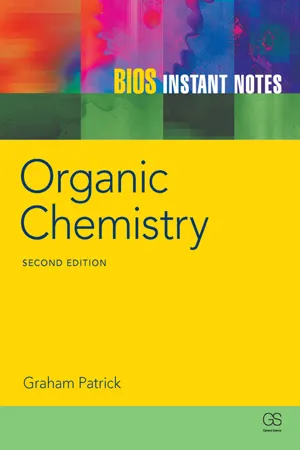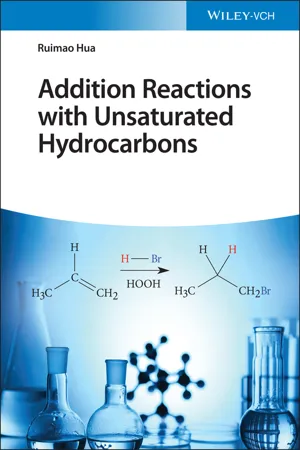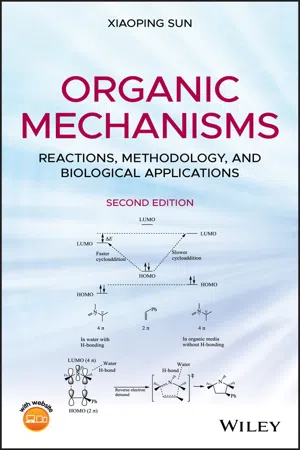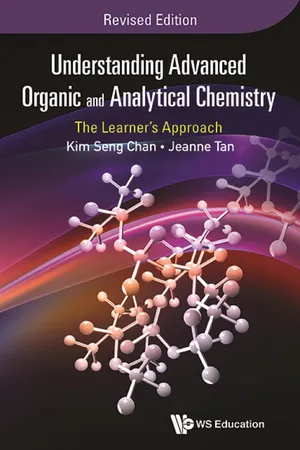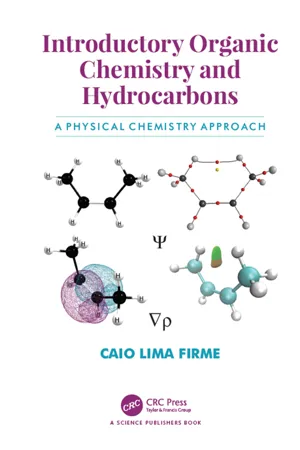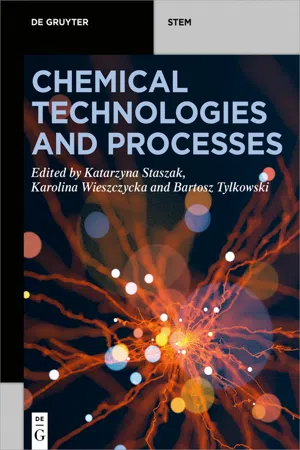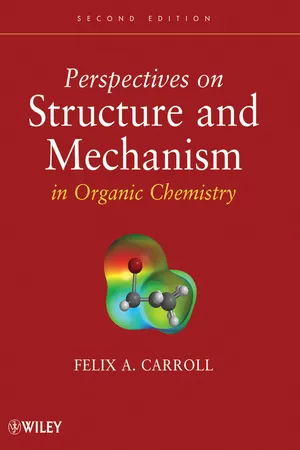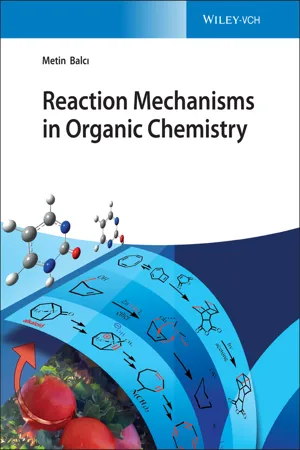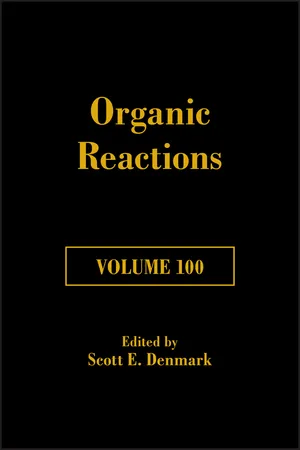Chemistry
Hydrohalogenation of Alkenes
Hydrohalogenation of alkenes is a chemical reaction in which a hydrogen halide (such as HCl or HBr) adds across the carbon-carbon double bond of an alkene, resulting in the formation of a halogenated alkane. The reaction proceeds via a carbocation intermediate and follows Markovnikov's rule, where the hydrogen atom adds to the carbon atom with more hydrogen substituents.
Written by Perlego with AI-assistance
Related key terms
Related key terms
1 of 4
Related key terms
1 of 3
11 Key excerpts on "Hydrohalogenation of Alkenes"
- eBook - ePub
- Andrew F. Parsons(Author)
- 2013(Publication Date)
- Wiley(Publisher)
5 Br.- An alicyclic halogenoalkane has the carbon atoms in a closed ring, but the ring is not aromatic, e.g. bromocyclohexane, C6 H11 Br.
- An aromatic halogenoalkane has the carbon atoms in a closed ring and the ring is aromatic, e.g. bromobenzene, C6 H5 Br.
The formation of bromobenzene from benzene is discussed in Section 7.2.15.2 Preparation
5.2.1 Halogenation of Alkanes
Chloroalkanes (RCl) or bromoalkanes (RBr) can be obtained from alkanes (RH) by reaction with chlorine or bromine gas, respectively, in the presence of UV radiation. The reaction involves a radical chain mechanism.Radicals are introduced in Section 4.1 Radical reactions are discussed in Section 4.6.2This is a substitution reaction as a hydrogen atom on the carbon is substituted for a Cl or Br atom. A mixture of halogenated products is usually obtained if further substitution reactions can take place.Chloroalkanes, such as CH2 Cl2 (dichloromethane), are common solvents in organic synthesisPrimary, secondary and tertiary halogenoalkanes are defined in Section 2.1The ease of halogenation depends on whether the hydrogen atom is bonded to a primary, secondary or tertiary carbon atom. A tertiary hydrogen atom is more reactive because reaction with a halogen atom (X• ) produces an intermediate tertiary radical, which is more stable (and therefore more readily formed) than a secondary or primary radical (Section 4.3).5.2.2 Halogenation of Alcohols
Alcohols (ROH) are converted into halogenoalkanes using a number of methods. All methods involve ‘activating’ the OH group to make this into a better leaving group (Section 5.3.1.4). Reaction mechanisms are introduced in Section 4.11The mechanism of these reactions depends on whether a primary (RCH2 OH), secondary (R2 CHOH) or tertiary alcohol (R3 - eBook - ePub
- Graham Patrick(Author)
- 2004(Publication Date)
- Taylor & Francis(Publisher)
Alkenes react with bromine or chlorine to produce vicinal dihalides with the halogen atoms adding to each end of the double bond. The reaction is useful in the protection or purification of alkenes or as a means of synthesizing alkynes. The halogen molecule is polarized as it approaches the alkene double bond thus generating the required electrophilic center. The intermediate formed is called a bromonium ion intermediate in the case of bromine and is stabilized since it is possible to share or delocalize the positive charge between three atoms. If the reaction is carried out in water, water can act as a nucleophile and intercept the reaction intermediate to form a halohydrin where a halogen atom is added to one end of the double bond and a hydroxyl group is added to the other. Alkenes to alcohols Alkenes can be converted to alcohols by treatment with aqueous acid (e.g. sulfuric acid). Milder conditions can be used with mercuric acetate to produce an organomercury intermediate which is reduced with sodium borohydride. Alkenes to ethers A similar reaction to the mercuric acetate/sodium borohydride synthesis of alcohols allows the conversion of alkenes to ethers. In this case, mercuric trifluoracetate is used. Alkenes to arylalkanes Alkenes can be reacted with aromatic rings to give arylalkanes. The reaction is known as a Friedel–Crafts alkylation of the aromatic ring but can also be viewed as another example of an electrophilic addition to an alkene. Related topics (E4) Organic structures (H4) Electrophilic addition to unsymmetrical alkenes (H5) Carbocation stabilization (H7) Hydroboration of alkenes (I3) Electrophilic substitutions of benzeneReactions
Many of the reactions which alkenes undergo take place by a mechanism known as electrophilic addition (Figure 1 ). In these reactions, the π bond of the double bond has been used to form a bond to an incoming electrophile and is no longer present in the product. Furthermore, a new substituent has been added to each of the carbon atoms.Figure 1. Electrophilic additions. - eBook - ePub
- Ruimao Hua(Author)
- 2022(Publication Date)
- Wiley-VCH(Publisher)
4 Hydrofunctionalization of Carbon–Carbon Double BondsSimilar to the addition reactions of H—heteroatom (E) bond to alkynes, the addition of alkenes with H—E bond has also been developed as one of the efficient and atom economical processes approach to functionalized alkanes [1] . In this chapter, the recent hydrofunctionalization of allenes [2] and 1,3‐dienes [3] will also be introduced in each section.The mechanism for the hydrofunctionalization of alkenes is essentially similar to that of alkynes as shown in Scheme 3.2 (Chapter 3 ), by replacement of alkyne with alkene.Some catalyst systems were found to show versatile catalytic activity to promote the addition reactions of different H—E bond to alkenes, such as FeCl3 /AgSbF6 [4] , FeBr2 /phosphine/phosphinite‐diimine ligand [5] , and manganese(II) bis(imino)‐pyridine compounds [6] . Organolanthanide complexes show catalytic activity in the stereoselective intramolecular cyclo‐hydroamination of aminoalkenes and cyclo‐hydrophosphination of phosphinoalkenes [7] .Intermolecular hydrofunctionalization of 1,3‐dienes usually gives a mixture of adducts; the high regioselectivity depends on not only the use of catalyst systems and reaction conditions but also the structures and natures of 1,3‐dienes [8] .4.1 Hydroboration of Alkenes
The cross‐coupling reaction of alkylboron compounds (boranes and boronate esters) is important and useful reaction via activation of C(sp3 )—B bond in the organic synthesis [9] . The B‐alkyl Suzuki–Miyaura reaction involving an sp3 carbon in the coupling event is important in the formation of C(sp3 )—C(sp2 ) bond, which has been well applied in the synthesis of natural products [10] - eBook - ePub
Organic Mechanisms
Reactions, Methodology, and Biological Applications
- Xiaoping Sun(Author)
- 2020(Publication Date)
- Wiley(Publisher)
11 ].Mechanism and transition states for halogenation of alkene in dichloromethane, an unreactive solvent.FIGURE 3.29Mechanism
The mechanism of alkene halogenations is illustrated in Figure 3.29 . In the first step of the reaction, an X2 (X = Cl or Br) molecule approaches the C=C π bond perpendicularly to the alkene molecule plane. This electrophilic attack leads to the formation of a cationic halogenium (chlorinium or brominium) intermediate (rate‐determining step) which is characterized by a positively charged C–X–C three‐membered ring [12 ]. The halogenium intermediate is analogous to the mercury(II)–alkene π complex as described in Section 3.1.3 and Figure 3.10 . The positive charge in the intermediate is delocalized to the two carbons. As a result, either of the carbon atoms can be subsequently attacked by a halide generated in the first step giving the final addition product (product‐development step). The identity of the product is determined by the relative stability of the transition state (TS ) of this product‐development step. The nucleophilic attack by X− (Cl− or Br− ) occurs preferably from the opposite side of the halogen atom in the halogenium intermediate giving rise to an overall major anti‐addition (two halogen atoms from X2 are added to the different sides of the C=C bond). The anti‐addition proceeds via a transition state (TS) in a staggered conformation. It is relatively more stable (than an eclipsed conformation) and possesses lower energy level, leading to a faster reaction for the product‐development step. The alternative syn‐addition would proceed via a relatively less stable transition state in an eclipsed conformation, with the two bromine atoms strongly interacting resulting in enhancement of the energy level and slowing down the reaction for the product‐development step. Therefore, the syn - eBook - ePub
Understanding Advanced Organic and Analytical Chemistry
The Learner's ApproachRevised Edition
- Kim Seng Chan, Jeanne Tan;;;(Authors)
- 2016(Publication Date)
- WS EDUCATION(Publisher)
CHAPTER 7
Halogen Derivatives
7.1 Introduction
Halogenoalkanes, also known as alkyl halides, are saturated organic compounds that contain the −C−X functional group (X = F, Cl, Br or I). They are important derivatives of alkanes and have the general formula Cn H2n+1 X. An example is bromoethane:Halogenoalkanes do not occur naturally. In fact, they are the by-products of the reaction of alkanes or alkenes with halogen, as these hydrocarbons are commonly found in petroleum. Halogenoalkanes are generally known as the “workhorse” in organic chemistry as they are very useful intermediates to be converted to other more important specialty chemicals of greater economic value. Some halogenoalkanes, such as chlorofluorocarbon, can also be harmful to the environment.Halogenoarenes (or aryl halides) are aromatic compounds with a halogen atom directly attached to the benzene ring. Similar to halogenoalkanes, halogenoarenes do not occur naturally and are in fact synthesized by reacting aromatic compounds isolated from petroleum with halogens.7.2 Nomenclature
A halogenolkane is obtained when one or more hydrogen atoms of an alkane molecule have been replaced by halogen atoms via the free radical substitution reaction. Other than this, halogenoalkanes can also be obtained when hydrogen halide (HX) or the diatomic halogen molecules add across an alkene double bond through the electrophilic addition mechanism. Thus, one can simply perceive halogenoalkanes as substituted alkanes. Therefore, halogenoalkanes are named in a similar manner to alkanes — the suffix ends in — ane - eBook - ePub
Introductory Organic Chemistry and Hydrocarbons
A Physical Chemistry Approach
- Caio Lima Firme(Author)
- 2019(Publication Date)
- CRC Press(Publisher)
the mechanism of Hydrohalogenation of Alkenes in polar, protic medium is also asynchronous concerted.POLAR ADDITION OF HYDROGEN HALIDE TO ALKENES: APOLAR SOLVENT
Second Order Kinetics
As mentioned above, there are three competing mechanisms for polar addition of HX to alkenes using apolar solvent. The second order kinetics has a much higher barrier than third and fourth order kinetics for polar HX addition in apolar solvent. Then, the polar addition of HX to alkenes in apolar solvent occurs mainly at low temperatures by fourth order kinetics and impurity-free media. However, when there are impurity traces, it was observed that second order kinetics is preferred, since the catalyst will be the impurity instead of one or two hydrogen halide besides the one adding to the alkene (Mayo and Katz 1947).Let us firstly show the mechanism of the second order kinetics of this reaction. We use hydrogen bromide and propene as an example of this mechanism in Fig. 17.5 . However, this is applicable to several other alkenes and also to hydrogen chloride replacing hydrogen bromide.Firstly, the reactants form a π complex, which is a minimum at PES where HBr is placed vertically towards the alkene’s π bond. Then, π bond electrons attack the hydrogen from HBr, promoting H-Br bond cleavage and σ electrons movement towards the bromine atom. During the transition state (which is associated with the rate determining step), alkene’s π bond and H-Br σ bond are partially broken to partially form a new bond (between one vinylic carbon and the hydrogen from HBr). Moreover, the opposite vinylic carbon holds a partial positive atomic charge (δ+ ) keeping its sp2 hybridization while the other vinylic carbon forming a new σ bond changes its hybridization to sp2.5 (in a pseudo-tetrahedral geometry) and halogen atom holds a partial negative atomic charge (δ + - eBook - ePub
- Katarzyna Staszak, Karolina Wieszczycka, Bartosz Tylkowski, Katarzyna Staszak, Karolina Wieszczycka, Bartosz Tylkowski(Authors)
- 2020(Publication Date)
- De Gruyter(Publisher)
S: Carboxylic acids or estersP: Acyl halogens Directly reaction of carboxylic acids or esters [15 ] with source of halogens, i.e. thionyl chloride (SOCl2 ), phosphorus trichloride (PCl3 ), phosphorus pentachloride (PCl5 ):Depending on the type of organic halogen compounds, different ways of synthesis (see Table 7.1 ), as well as different technologies, are proposed in the literature and industry, which will be discussed, in detail, in the following sections. Particular attention was given to the compounds with the widest industrial applications.7.2 Alkyl halides
Alkyl halides, known as haloalkanes, are a group of organic chemical compounds derived from alkanes in which one or more hydrogen atoms have been replaced by a halogen atom (see Figure 7.1 ). Similar to alcohols, alkyl halides could be divided into different classes depending on how the halogen atom is positioned on the chain of carbon atoms: i. primary alkyl halides (RCH2 X), ii. secondary alkyl halides (R2 CHX) and iii. tertiary alkyl halides (R3 CX).7.2.1 Chloromethanes
The simplest example of haloalkanes is chloromethane (known also as methyl chloride, Refrigerant-40, R-40 or HCC 40). In industrial practice, two methods of its synthesis are applied: chlorination of CH4 or hydrochlorination of methanol. Global chloromethane market was esteemed at 1.8 billion US$ in 2017 and is expected to reach 2.5 billion US$ in 2026, at a CAGR of 4.21 % during a forecast period [16 ].Due to ta cascade reaction in chlorination process, the other products are also obtained: dichloromethane, chloroform, and carbon tetrachloride. From the practical point of view, generally synthesis of all compounds is realized in the industry process simultaneously. Dichloromethane (known also as Refrigerant-30, Freon-30, R-30, DCM) is a popular solvent in organic chemistry. Carbon tetrachloride (known also as Freon-10, Refrigerant-10, Halon-104) was often used as solvent and in fire extinguishers, as a precursor to refrigerants and as a cleaning agent, in the last century. Nowadays, due to its toxicity the application is limited. - No longer available |Learn more
- Felix A. Carroll(Author)
- 2011(Publication Date)
- Wiley(Publisher)
5Many different mechanisms have been proposed for addition reactions, and they have long been described in terms of the Ingold formalism.6 In this system, addition reactions are labeled with symbols incorporating Ad for addition, E or N for electrophilic or nucleophilic, and a number indicating the molecularity of the reaction.7 For example, an AdE 2 mechanism involves attachment of an electrophile to the substrate, followed by attachment of a nucleophile to the resulting intermediate. The corresponding IUPAC term for the same reaction would be (AE + AN ).8 Because most of the literature of organic chemistry has been written using the Ingold terminology, we will note the IUPAC nomenclature but will usually discuss reactions in terms of the more familiar Ingold designations.9.2 ADDITION OF HALOGENS TO ALKENES Electrophilic Addition of Bromine to Alkenes IntroductionOne of the classic reactions of organic chemistry is the addition of bromine to an alkene.9– 11 We will first summarize the evidence that led to the textbook mechanism (shown in Figure 9.2 ), and then we will survey experimental data that reveal the complexities underlying this simple mechanistic representation.Two important features of the mechanism shown in Figure 9.2 are:1. The intermediate is a bromonium ion, a three-membered ring contain ing a bromine atom bearing a formal charge of +1. The structure is also called a σ complex, because the valence bond representation implies a full or partial σ bond between the olefinic carbon atoms and the bromine atom.12 - J. Grimshaw(Author)
- 2000(Publication Date)
- Elsevier Science(Publisher)
CHAPTER 2OXIDATION OF ALKANES, HALOALKANES AND ALKENES
Radical-Cations
Oxidation of alkanes involves the removal of an electron from either a carbon-hydrogen or a carbon-carbon σ-bond. These are dissociative processes where the radical-cation cannot be detected as an intermediate in either fluorosulphuric acid or acetonitrile.Oxidation of iodoalkanes involves removal of an electron from the halogen non-bonding orbital. The radical-cations of primary and secondary alkyl iodides can be identified in aqueous solution by their absorption spectra and have half-lives of microseconds [1 ]. They are formed during pulse radiolysis of the iodoalkane in aqueous solution in the presence of nitrous oxide. This system generates hydroxyl radicals, which remove an electron from the iodine atom lone pair. Iodoalkane radical-anions complex with the lone-pair on other heteroatoms to form a 2σ/1σ* three-electron bond. In aqueous solution, the radical-cation of iodomethane is involved in an equlibrium indicated by Equation 2.1 .Eq. 2.1Related three-electron bond radical-cations 1 are formed from dialkyl sulphides by oxidation with hydroxyl radicals generated using pulse radiolysis [2 ]. An isoelectronic three-electron bond between two nitrogen atoms in 2 is formed by reductionof the hydrazine dication with sodium in liquid ammonia. This species is sufficiently stable to be sublimed in vacuum as the tetrafluoroborate salt [3 ].Electrochemical oxidation of alkenes results in the removal on one electron from the alkene function to give a π-radical-cation where the electron deficiency is delocalised over the conjugated system. The majority of alkene radical-cations cannot be characterised because they readily lose an allylic proton in aprotic solventsor react with any nucleophile present in solution. Important exceptions are the radical-cations of the rigid adamantane derivatives 3 and 4- eBook - ePub
- Metin Balc?, Metin Balc?, Metin Balc?, Metin Balc?, Metin Balc?(Authors)
- 2021(Publication Date)
- Wiley-VCH(Publisher)
As σ-bonds are more stable than π-bonds, the most common reaction of C=C double bonds is the transformation of π-bonds into σ-bonds. When alkene and hydrogen gases are reacted in the presence of a catalyst, such as platinum, palladium, or nickel, two hydrogen atoms add to the C=C double bond to yield alkanes [94]. This reaction is called hydrogenation. The reaction is exothermic and the heat released is called the heat of hydrogenation and is about −20 to −30 kcal/mol (−80 to 125 kJ/mol), indicating that the product formed is more stable than the alkene. In this section, we will focus only on the reduction of carbon–carbon double bonds as a wide variety of functional groups can be reduced by catalytic hydrogenation. Depending on the type of the catalyst and reaction conditions, the reduction reactions are categorized into two groups: Heterogeneous catalytic reduction Homogeneous catalytic reduction 4.7.1 Heterogeneous Catalytic Reduction Heterogeneous catalysts have their advantages and disadvantages. After completion of the hydrogenation reaction, the heterogeneous catalysts are separated by filtration from the reaction medium because they do not dissolve in solvents. Hydrogenation reactions are generally carried out with heterogeneous catalysts. Alkenes do not react directly with hydrogen gas under normal conditions. A temperature of at least 500 °C is required for the reaction to take place. The activation energy required for adding hydrogen is quite high. The hydrogen–hydrogen bond must be weakened for reduction. Otherwise, it is also a challenging process. The activation energy of hydrogenation reactions decreases when a catalyst is used. The task of the catalyst is to lower the activation energy (Figure 4.2). Generally, the alkene is dissolved in alcohol, hydrocarbon, or acetic acid. A small portion of the catalyst is added to the reaction mixture. The reaction proceeds using hydrogen at atmospheric pressure - eBook - ePub
- (Author)
- 2019(Publication Date)
- Wiley(Publisher)
CHAPTER 7 HYDROFUNCTIONALIZATION OF ALKENES BY HYDROGEN‐ATOM TRANSFER Ryan A. Shenvi Jeishla L. M. Matos and Samantha A. GreenDepartment of Chemistry, The Scripps Research Institute, BCC 415, La Jolla, CA, 92037CONTENTS
- Introduction
- Mechanism and Stereochemistry
- General Mechanistic Overview
- Experimental Support for MHAT
- Ambiguities and Missing Experiments
- Stereochemistry
- Scope and Limitations
- C–O Bond Formation
- Hydration
- Hydroperoxidation
- Ketone Formation
- Hydroalkoxylation
- C–N Bond Formation
- Hydrooximation
- Hydrohydrazidation
- Hydroazidation
- Formation of Hydrazones
- Hydroamination
- C–X Bond Formation
- Hydrofluorination
- Hydrochlorination
- Hydrobromination/Iodination/Selenylation
- Hydrosulfenylation
- C–C Bond Formation
- Addition to C=C Bonds
- Addition to C=N and C=O Bonds
- Hydroarylation and Minisci‐Type Reaction
- Hydrocyanation
- Hydroalkenylation and Hydroalkynylation
- Hydrogenation and Isomerization
- Hydrogenation
- Isomerization
- C–O Bond Formation
- Applications to Synthesis
- Examples of C–O Bond Formation in Synthesis
- Examples of C–C Bond Formation in Synthesis
- Examples of Hydrogenation and Isomerization in Synthesis
- Comparison With Other Methods
- Hydrofunctionalization via Metalation
- Brønsted and Lewis Acid Catalysis
- Directed Functionalization
- Experimental Conditions
- Experimental Procedures
-
- 4‐(1,1‐Dimethylethyl)‐1‐[(triethylsilyl)oxy]cyclohexyl Triethylsilyl Peroxide [Peroxidation of a Silyl Enol Ether].50
- 1‐(4‐Methoxyphenyl)ethan‐1‐one [Ketone Formation from a Vinyl Halide].52
- (4R) 4‐(1‐Azido‐1‐methylethyl)‐1‐methyl‐7‐oxabicyclo[4.1.0]heptane [Azidation of an Unactivated C=C Double Bond with NaN3 ].61
- 3‐Methyl‐3‐(naphthalen‐1‐ylamino)butan‐1‐ol [Intermolecular Hydroamination].64
- tert‐Butyl (3aS,4R,6S,6aR)‐2,2‐Dimethyl‐6‐(2‐(methylthio)propan‐2‐yl)tetrahydro‐3aH‐cyclopenta[d][1,3]dioxol‐4‐ylcarbamate [Hydrosulfenylation of a C=C Double Bond with Tosyl Sulfide].69
- 3‐{2‐[(tert
-
Index pages curate the most relevant extracts from our library of academic textbooks. They’ve been created using an in-house natural language model (NLM), each adding context and meaning to key research topics.
Explore more topic indexes
Explore more topic indexes
1 of 6
Explore more topic indexes
1 of 4

